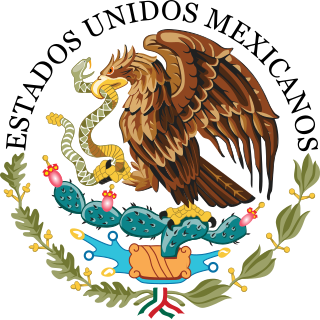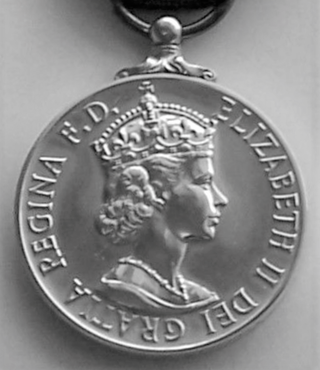
The Legion of Merit (LOM) is a military award of the United States Armed Forces that is given for exceptionally meritorious conduct in the performance of outstanding services and achievements. The decoration is issued to members of the eight uniformed services of the United States as well as to military and political figures of foreign governments.

The Order of Merit is an order of merit for the Commonwealth realms, recognising distinguished service in the armed forces, science, art, literature, or the promotion of culture. Established in 1902 by Edward VII, admission into the order remains the personal gift of its Sovereign—currently Edward VII's great-great-grandson, Charles III—and is restricted to a maximum of 24 living recipients from the Commonwealth realms, plus a limited number of honorary members. While all members are awarded the right to use the post-nominal letters OM and wear the badge of the order, the Order of Merit's precedence among other honours differs between countries.

The King's Police Medal (KPM) is awarded to police in the United Kingdom for gallantry or distinguished service. It was also formerly awarded within the wider British Empire, including Commonwealth countries, most of which now have their own honours systems. The medal was established on 7 July 1909, initially inspired by the need to recognise the gallantry of the police officers involved in the Tottenham Outrage. Renamed the King's Police and Fire Services Medal (KPFSM) in 1940, it was replaced on 19 May 1954 by the Queen's Police Medal (QPM), when a separate Queen's Fire Service Medal was also instituted. The current award was renamed the King's Police Medal following the death of Queen Elizabeth II in 2022 and the accession of King Charles III to the throne of the United Kingdom.
The orders, decorations, and medals of Canada comprise a complex system by which Canadians are honoured by the country's sovereign for actions or deeds that benefit their community or the country at large. Modelled on its British predecessor, the structure originated in the 1930s, but began to come to full fruition at the time of Canada's centennial in 1967, with the establishment of the Order of Canada, and has since grown in both size and scope to include dynastic and national orders, state, civil, and military decorations; and various campaign medals. The monarch in right of each Canadian province also issues distinct orders and medals to honour residents for work performed in just their province. The provincial honours, as with some of their national counterparts, grant the use of post-nominal letters and or supporters and other devices to be used on personal coats of arms.
Awards and decorations of the United States Department of the Air Force are military decorations which are issued by the Department of the Air Force to airmen of the United States Air Force and guardians of the United States Space Force and members of other military branches serving under Air Force and Space Force commands.
Awards and decorations of the United States government are civilian awards of the U.S. federal government which are typically issued for sustained meritorious service, in a civilian capacity, while serving in the U.S. federal government. Certain U.S. government awards may also be issued to military personnel of the United States Armed Forces and be worn in conjunction with awards and decorations of the United States military. In order of precedence, those U.S. non-military awards and decorations authorized for wear are worn after U.S. military personal decorations and unit awards and before U.S. military campaign and service awards.
The following is the Canadian order of precedence for decorations and medals in the Canadian Honours System. Where applicable, post-nominal letters are indicated.

The King's Gallantry Medal (KGM), formerly the Queen's Gallantry Medal (QGM), is a United Kingdom decoration awarded for exemplary acts of bravery where the services were not so outstanding as to merit the George Medal, but above the level required for the King's Commendation for Bravery.
South African orders, decorations and medals are those military and civilian orders, decorations and medals issued by the Government of South Africa. The following is a (non-exhaustive) list of these:

This is a list of military decorations awarded by the United Mexican States as part of the Mexican Honours System.
The King's Fire Service Medal, introduced in 1954, is awarded to members of the fire services in the United Kingdom for distinguished service or gallantry. It was also formerly awarded by Commonwealth countries, most of which now have their own honours systems.
Portugal has a system of orders, decorations, and medals as a means of honouring individuals for personal bravery, achievement, or service to Portugal.

The King's Volunteer Reserves Medal (KVRM) was created by Royal Warrant of Queen Elizabeth II on 29 March 1999. Only 13 King's Volunteer Reserves Medals may be awarded in a year. The medal is presented only to members of the Volunteer Reserves of the British Armed Services for exemplary meritorious service in the conduct of their duties. The KVRM is a Level 3 award and ranks in military order of wear immediately after the British Empire Medal. It is the first exclusive award to Volunteer Reserves that is presented at an investiture. The first awards were announced in the 1999 Queen's Birthday Honours with these first awards presented at an investiture on 5 November 1999.
The Canadian Coast Guard Exemplary Service Medal is a service medal created in 1991 by the Canadian monarch-in-Council to recognize members of the Canadian Coast Guard or a supporting organisation who had served for 20 years, half of which time was spent in operations that involved possible personal risk. It is, within the Canadian system of honours, the third lowest of the exemplary service medals.

The New Zealand Distinguished Service Decoration (DSD) was instituted by Royal Warrant as a New Zealand Royal Honour in 2007 to recognise distinguished military service, by regular, territorial and reserve members of the New Zealand Defence Force. Until 1995, this type of service was recognised by awards of the British Empire Medal (Military Division). After the change to a totally New Zealand Honours system in 1996, these Commonwealth awards were not available to be awarded to New Zealand military personnel.

The Royal Order of the Crown of Tonga is an Order of Merit awarded for exceptional services to Tonga and the Crown of Tonga. Currently, it is the highest honor conferred by the Kingdom of Tonga.

The Ambulance Service Long Service and Good Conduct Medal is a long service medal of the United Kingdom established in 1995. The medal is awarded to recognise long service by all clinical grades of the ambulance services who serve on emergency duty.
The State of Queensland has created several independent honours to that of the Australian Honours System.

The Police Coronation Medal was sanctioned in 1911 as an award to policemen, members of ambulance units, firemen and Royal Parks' staff on duty during the official celebrations of the coronation of King George V that took place during 1911.
The State of New South Wales has created several independent honours to that of the Australian Honours System.









